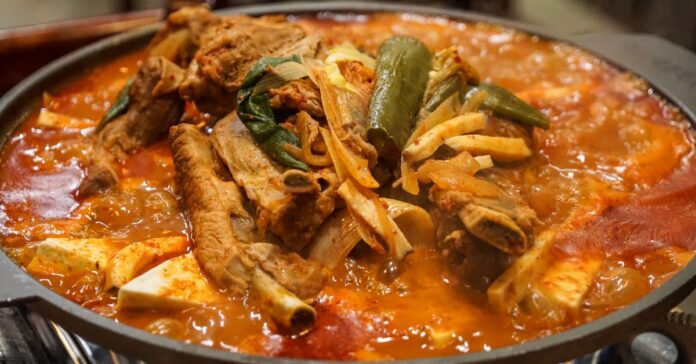In the current milieu of LA’s Koreatown restaurants, it’s rare for a new soup contender to come onto the scene, given how competitive and often cost-prohibitive it can be in the neighborhood. But that’s what owner Woosuk Lee was hoping for when he debuted LeeGa back in October 2022, recognizing that there hadn’t been a star soup restaurant to open in the neighborhood for many years. Since its opening, LeeGa (pronounced ee-gah) has garnered social media attention and a loyal K-Town following in the bustling strip mall that houses Kobawoo, Alchemist Coffee, and 7 Korean BBQ. But what really separates LeeGa is a tight menu that serves some of Koreatown’s best hangover soups, naengmyeon, and handmade dumplings.
For traditional Korean restaurants in Los Angeles, the approach is usually split into two ways: a comprehensive menu with plenty of familiar favorites like doenjang jjigae, bibimbap, and bulgogi; or a focus on just a few items, like barbecue, pan-fried fish, or even stews. One of those specialties, soup, has become the basis for a whole genre of traditional Korean restaurants. One of the most prominent is seolleongtang, a bone broth soup that uses a milky broth with long-boiled bones mixed with either wheat or potato vermicelli noodles, and various cuts of beef, typically brisket.
:no_upscale()/cdn.vox-cdn.com/uploads/chorus_asset/file/24675064/image0__3_.jpeg)
Lee, who brings 14 years of experience as a sushi chef and has owned Marina del Rey’s Tomi Sushi since 2018, says LeeGa “is the right taste for Korean people.” That line could be an unintentional dig at the status quo, one that already features popular seolleongtang restaurants Han Bat on Western Avenue and Yong Dong on Wilshire Boulevard. In the past few years, newer players to the seolleongtang scene have sprouted up in LA’s Koreatown, including Master Ha (which first opened in 2017, and only recently reopened after a three-year hiatus), Yuk Dae Jang, and Haemaru, all of which serve Korean soup and a smattering of other dishes to complement them.
So why open a Korean soup place in a neighborhood chock-full of them? Lee said that when he goes out to a lot of other Korean restaurants, he doesn’t think the taste reflects what Koreans want, as the flavor profiles are often either too sweet or salty. “I want to let everyone know the exact taste of Korean soup and noodles,” he says.
:no_upscale()/cdn.vox-cdn.com/uploads/chorus_asset/file/24674974/LeeGa.jpg)
:no_upscale()/cdn.vox-cdn.com/uploads/chorus_asset/file/24674984/LeeGa_8.jpg)
:no_upscale()/cdn.vox-cdn.com/uploads/chorus_asset/file/24675018/LeeGa_7.jpg)
:no_upscale()/cdn.vox-cdn.com/uploads/chorus_asset/file/24675019/LeeGa_6.jpg)
Seolleongtang restaurants are their own subculture, drawing hungover folks in the morning for a comforting bowl of piping hot soup. If soup is the backbone of Korean cuisine, then seolleongtang is a prime player in Korean restaurant culture. Unlike a lot of other traditional Korean dishes, the labor and time involved with making the dish makes it easier to enjoy in restaurants than at home (though, there are invariably plenty of people who regularly make their own seolleongtang).
LeeGa’s menu starts with seolleongtang (spelled suhlung tang here), with options for brisket, flank, and assorted cuts. The cloudy broth comes out bubbling, served with banchan of napa cabbage kimchi, kkakdugi (spicy pickled Korean radish cubes), and acorn jelly covered in soy sauce and minced scallions. Galbitang sports a clear, intensely savory broth and whole beef ribs that diners will have to gnaw the meat off of (you could also use scissors and tongs like a civilized person). Dumplings, shaped like half-moons and stuffed with either minced beef, pork, vegetable, or kimchi-and-meat, come with a dipping sauce of shaved onions with soy sauce and vinegar. Pliant, pasta-like wrappers rolled out in the kitchen become translucent. These dumplings resemble some of the best ones from Seoul’s famed Gwangjang Market, and they’re so big it almost takes two bites to finish one.
:no_upscale()/cdn.vox-cdn.com/uploads/chorus_asset/file/24674985/LeeGa_4.jpg)
:no_upscale()/cdn.vox-cdn.com/uploads/chorus_asset/file/24674988/LeeGa_1.jpg)
:no_upscale()/cdn.vox-cdn.com/uploads/chorus_asset/file/24674991/LeeGa_5.jpg)
:no_upscale()/cdn.vox-cdn.com/uploads/chorus_asset/file/24675001/LeeGa_3.jpg)
Another specialty here is the mul naengmyeon. The celebrated North Korean cold beef noodle soup acts as a litmus test given the subtleties the kitchen must achieve between the richness and tanginess of the broth. Too subtle, and the soup lacks flavor. Too sweet or tangy, and the soup will get dismissed as inauthentic. LeeGa rides a fine line but errs closer to subtlety here, which reflects a mild Pyongyang naengmyeon-style broth. But LeeGa uses a bit of a trump card when it comes to the noodles. Thin strands of buckwheat are pulled straight from a machine that looks like a giant garlic press, delivering the slightly nutty, chewy noodles straight into boiling water. It’s worth trying LeeGa’s version for this reason alone since most places just use pre-made. Noodle fans should also try the hard-to-find jengban naengmyeon, mixed with a spicy-sweet sauce surrounded by sliced vegetables, beef, and raw fish.
Once a first-time diner tries the soups, dumplings, and naengmyeon at LeeGa, the next step would be to share the tableside stews and braised meats. The seok galbi is a particular innovation, a spin on more common galbijjim but with soy-marinated beef short ribs first grilled and then finished in a shallow pool of broth. It’s half-prepared in the kitchen and then left to finish on the table over a camp stove, with slivers of potato and shredded green onions left to soak up the intensifying juices and broth. LeeGa serves a pork spare rib and bulgogi version of that dish, but the most hardcore stew on the menu might be the muk eun ji daeji jjim, a stew of aged kimchi turbocharged with umami served with chunks of tender pork shoulder.
With almost nine months of successful operation so far, Lee hopes to open LeeGa in other communities across Southern California if this location continues to develop a following, like Buena Park, Torrance, Irvine, and Gardena, cities that already boast their own Korean restaurant scenes.
LeeGa is located at 698 S. Vermont Avenue, Suite 106, Los Angeles, CA, and is open Wednesday to Monday, 11 a.m. to 10 p.m.



